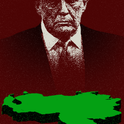Yesterday evening, President Donald Trump gave his first address to both Houses of Congress. It marked a significant change in tone from the “American carnage” motif of his inaugural address. It was altogether softer, more considered—even optimistic and presidential, according to the write-ups of political pundits. The reasons for this remain the subject of speculation, but his low approval ratings, a turbulent first few weeks in the White House, and the need to win over lukewarm friends in Congress must all have played a part.
The rhetoric on immigration, one of the administration’s core policy areas, was more mixed than screeching. The president expressed support for NATO, and didn’t even mention Russia or China. Not even mainstream media cropped up. Yet behind the softer colours of this address, there was still a strong sense of economic nationalism and assertion of US sovereignty that are the trademarks of his more ideological speech-writers and advisers in the White House.
If the speech was supposed to sketch the president’s core beliefs and direction of policy, it did no more than that. Details were for the most part absent. But over the last 24 hours or so, we have learned a little about the president’s intentions.
He wants to present to Congress a $54bn shopping list of extra defence spending, representing a 10 per cent increase over the budget cap currently set in law. This would take US defence spending back over $600bn, still lower than in the aftermath of the Iraq war, but 50 per cent more than at the time of the last trough in 2000. It would also be more than the entire defence budgets of the next seven biggest spenders combined—including China, whose spending is about a third of the US’. To win over Congress, the president will propose swingeing cuts in non-defence spending, including that of the State Department and the Environmental Protection Agency.
The funding wasn’t referred to in yesterday’s speech but will become a big issue in the next two months. Remember that 60 per cent of federal spending is mandatory. That is subject to law, and comprises Medicare and Medicaid and Social Security. Squeezing the other 40 per cent to fund defence, infrastructure, tax cuts, and any replacement for the Affordable Care Act, aka Obamacare, is going to be extremely painful and could simply result in significantly higher budget deficits.
The president also explained, to muted applause it should be said, that he will present a $1trn infrastructure programme, noting that the last time the US even entertained such an initiative was under President Dwight Eisenhower. Again, funding was not mentioned, except that it would be through public and private efforts. The details will determine how successful the programme will be. The thinking in Trump’s team to date has been that it will be financed largely via tax credits for construction companies, but these might cherry-pick the most profitable projects and won’t necessarily address the needs of the economy and local communities.
The repeal and replacement of Obamacare was also centre-stage in Trump’s address, but, again, there were no details. Recent developments point to some interesting phenomena. An upsurge in activism in communities, online and in appeals to lawmakers has made clear how on the path to repeal and replacement there are few—if any—way markers for determining which proposals are acceptable. At the same time, Trump’s ideologues in the White House have emphasised the political costs of dismantling Obamacare too fast or aggressively. Taking health insurance and medical care away from millions of Americans without a plausible substitute scheme in place is, even for them, worth hesitating over.
“Historic” tax reform proposals will be forthcoming from the White House, and of that we can be sure. They will focus on reform of the corporate tax system, most likely including significant reductions in corporate tax rates, and possibly the introduction of a so-called border tax, which would shift the tax system away from earnings to the location of sales. In a nutshell: imports would be taxed and exports would receive a de facto subsidy—so this can also be seen as a form of corporate protectionism. The president seems to be warm to—but not yet won over by—this idea. There will also be “massive” tax relief for the middle class, though most independent tax experts see this as code for tax breaks that will benefit the top 1 per cent of earners disproportionately.
Other items the president mentioned included the provision of accessible and affordable childcare, paid family leave for new parents, extra funding for women’s health, an education bill to fund school choice for disadvantaged young people, and, despite a recent Executive Order to review the Clean Water Act, for clean air and water.
As with everything else, the devil will be in the detail, and ultimately in the willingness of Congress to go along with unfunded spending increases. Republicans were adamantly against this during eight years of Democratic Administration, and it remains to be seen if its fervour remains as strong.
Financial markets will not have been especially moved by this speech for there was nothing of consequence on which to base any new opinions. They crave details about the new tax and infrastructure regimes, and the extent to which business will be influenced by deregulation and changes to the tax code.
Most of all, though, we are left guessing at this early stage in the presidency about two key issues. First, what the most protectionist rhetoric in a generation will mean for trade and America’s engagement with the world system and global institutions. Second, what a militaristic “America First” government means for the world order and for the predictability that is central to the world’s economic well-being.
Trump’s Congress speech: The same man but in softer colours
The details were predictably hazy, but a policy picture is gradually emerging
March 01, 2017

United States President Donald J. Trump delivers his first address to a joint session of the US Congress in the US Capitol in Washington, DC, USA, February 28, 201 ©Kleponis Chris/CNP/ABACA/ABACA/PA Images











